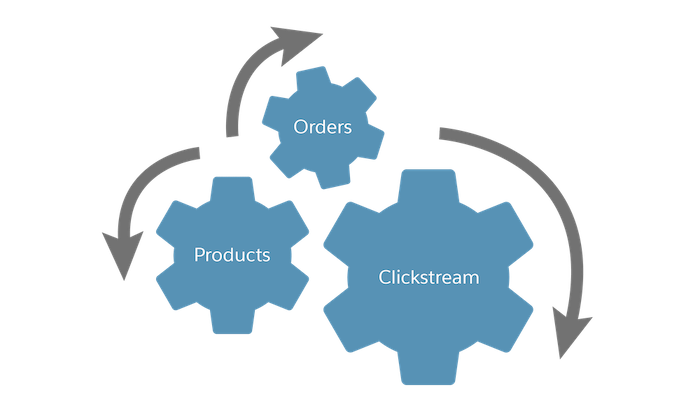Get to Know Commerce Cloud Einstein
Learning Objectives
After completing this unit, you’ll be able to:
- List three types of data that Commerce Cloud Einstein tracks.
- List three ways that Einstein improves a shopper’s experience.
- Describe the two Einstein search features.
- Explain the differences between Einstein Search and Product Recommendations.
What Is Einstein
Linda Rosenberg is a site administrator for Cloud Kicks, a company that specializes in high-end custom sneakers. The Cloud Kicks ecommerce site runs on Salesforce B2C Commerce, part of Salesforce Commerce Cloud. Recently, Cloud Kicks management learned about the benefits of Commerce Cloud Einstein. They ask Linda to deploy it to the Cloud Kicks site.

Before Linda starts, she wants to learn what Commerce Cloud Einstein is and how it can help her company’s business.
Commerce Cloud Einstein is artificial intelligence (AI) embedded right in the application. Just like Einstein in the Salesforce core platform, merchants using B2C Commerce can easily access the power of predictive intelligence without having to hire a data scientist, use a costly third-party recommendations provider, or create a home-grown solution.
She learns that with Einstein, you can:
- Use shopper behavior to deliver tailored product sorts.
- Decrease the time a customer spends looking for what they want.
- Increase the likelihood of a purchase.
- Bring personalization into the commerce experience for all shoppers, improving their experience.
Because Einstein is embedded in B2C Commerce, data collection has no measurable effect on the shopper experience. There’s no additional contract or payment required to use it.
Although it’s embedded, you still need to enable and implement it. Let’s see what that means.
Enablement is when you... |
|
|---|---|
Implementation is when you... |
|
Linda's part of the job is enablement.
Data Is Key
Einstein needs data and all storefronts have it. So how much data does it need? Two years of data is ideal, but data is useful to Einstein soon after a storefront is live. Einstein uses the following data.
- Clickstream
- Products
- Orders

Clickstream is anonymous data on shopper behavior. The shopper’s browser sends information to B2C Commerce servers each time the shopper:
- Views a product or page
- Views or clicks a recommendation
- Performs or refines a search
- Adds a product to cart
- Removes a product from the cart
- Finishes checkout
This is the data it sends.
- Timestamps
- Cookies
- Activity types (product view, page view, add to cart, remove from cart, finish checkout, view category, view search, click a category, customer sign-up)
- Product data, such as the product ID of the current page
- Category data, such as the category ID of the current page
- Search terms and search refinements
- IP address
- User-Agent (the browser, version, and operating system that the shopper is using)
Einstein aggregates this data for benchmarking and analysis, making intelligent data-driven personalization possible. Merchants like Cloud Kicks can:
- Personalize recommendations.
- Personalize search results and category grid sorting.
- Identify new search synonyms.
- Analyze shopper baskets to identify products that are commonly purchased together.
- Provide shoppers with type-ahead search guidance, recent personal searches, and popular storefront searches.
Commerce Cloud Einstein Features
The merchandisers in Linda’s company want to use Einstein features to personalize the shopper experience and automate personalization-related tasks. These are the features they want to use.
Feature |
Description |
|---|---|
Commerce Insights |
Captures shopper, order, and product data and displays products that are most commonly purchased together. Merchandisers can use this info to create product bundles, deals, and “complete the look” suggestions. |
Einstein Search Dictionaries |
Consumes site searches and terms used in searches that are not in the keyword list and makes recommendations to add them. |
Einstein Search Recommendations |
Performs personalized term completion and corrections, and provides recommendations from recent search phrases, and popular or trending search phrases based on predictive intelligence. |
Einstein Predictive Sort |
Sorts search results or the product display grid based on predictive intelligence. |
Einstein Product Recommendations |
Provides personalized product recommendations based on an individual shopper’s experience. |
Who Does What?
The Cloud Kicks storefront is already live, so Linda can enable Commerce Cloud Einstein immediately, or as soon as she gets the team together and they create a plan. These are the people that Linda works with for the deployment.
-
Developer: Creates and changes code and templates and tests.
-
Merchandiser: Configures Business Manager and Configurator settings and tests the results.
Size the Effort
The team considers the level of effort required to implement the features that Cloud Kicks wants.
Feature |
Developer |
Merchandiser |
Average Time to Complete |
|---|---|---|---|
Commerce Insights |
None |
Review routinely with Marketing team to develop new product-centric campaigns. |
Immediate |
Einstein Search Dictionaries |
None |
To accept or deny synonym suggestions go to Business Manager > site > Merchant Tools > Search > Search Dictionaries Search > Search Dictionaries to enable Search Preferences Search > Search Preferences to add your email for notifications |
Immediate |
Einstein Search Recommendations |
Required |
If search flyout exists, configure in Business Manager. Configure and test. |
Varies: Immediate to 2 sprints |
Predictive Sort |
None |
Copy existing sorting rule and apply predictive sort. Configure and test. |
Immediate |
Product Recommendations |
Define rendering templates for recommendation type slots. |
Create recommenders in Configurator. Configure in the given content slot within Business Manager, test and replicate content slots. |
2 sprints |
Enablement Components
Linda learns that the Cloud Kicks developers already prepped the site for enabling Einstein. Prior to go-live, developers created templates and code with Einstein in mind. For example, the content slot rendering and related storefront template code they developed pre-launch follows Einstein best practices. That’s great news!
Next, Linda needs to understand which components to use to enable and implement Commerce Cloud Einstein.
Feature |
Configurator |
Development Element |
Business Manager |
A/B Testing |
|---|---|---|---|---|
Commerce Insights |
Yes |
No |
No |
No |
Einstein Search Dictionaries |
No |
No |
Search > Search Dictionaries to enable Search > Search Preferences to add your email for notifications |
No |
Einstein Search Recommendations |
No |
Search flyout |
No |
No |
Einstein Predictive Sort |
No |
No |
Sorting Rules |
Yes |
Einstein Product Recommendations |
Yes |
New recommendation slot rendering templates |
New slot configuration to use Einstein recommender |
Yes |
Implementation Tips and Resources
The merchandisers play a big role in implementing Commerce Cloud Einstein and acting on the insights it uncovers. So the CSM also points out some resources to help them learn more about Commerce Cloud Einstein. These come in handy when the merchandisers plan the best ways to inject AI into the shopper experience.
- The B2C Commerce Einstein Platform Adoption Workshop.
- 1:1 with a Salesforce field specialist in Accelerator engagements (see your customer success manager).
- Partner resources: the Partner Community > Commerce Cloud Chatter group.
Next Steps
In this unit, Linda Rosenberg learned about the data that Commerce Cloud Einstein collects and how Einstein can enhance the shopper experience in a storefront. She explored Commerce Cloud Einstein features, who’s involved in enablement and implementation, and the effort required per feature. Next, she explores how to plan for enablement and implementation.